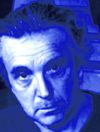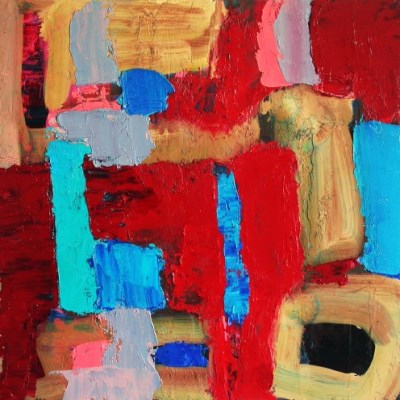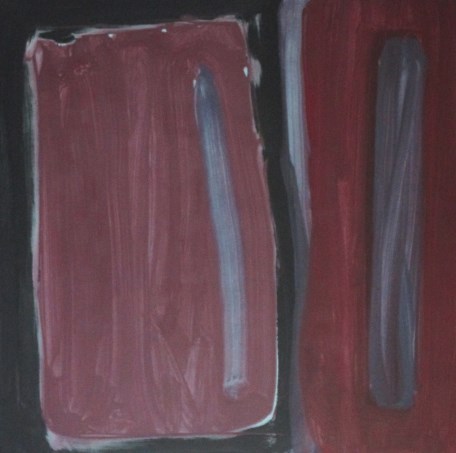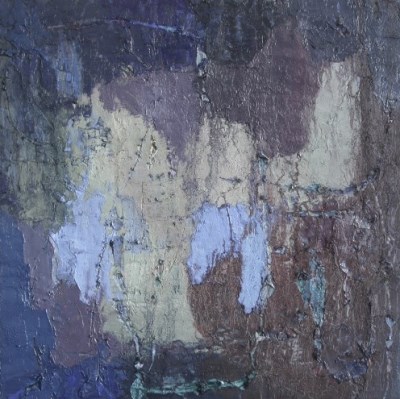the art of
ROBERTO ROMEI ROTONDO

by
BETSY
L. CHUNKO
___________________________________________
Betsy
Chunko holds graduate degrees in both art history and literature.
She earned her PhD from the University of Virginia and currently
teaches at Bard College in Annandale-on-Hudson, NY.
As
stated by artist Roberto Romei Rotondo, “A good deal
has been written up on [me], much of it trash.” Genius
is, they say, volatile. Widely exhibited, the artist was born
in Milan and studied in Montreal under Guido Molinari. Yet
the effects of the teacher on the pupil seem remarkably subtle.
Instead, much of Rotondo’s work appears a reinterpretation
of a longer, broader history of art -- often incorporated
or recollected only to be  overturned,
challenged, or subverted, perhaps unconsciously.
overturned,
challenged, or subverted, perhaps unconsciously.
The
artist’s portraits have garnered a great deal of attention
-- particularly his eerie gallery of haunting, ‘woeful’
women. Yet his abstract, non-figural work is perhaps the more
striking in certain regards, particularly the remarkable Meltdown
Series. Modern art implies ‘insider knowledge’
and history; this is one reason it can be difficult. Difficulty
is actually a theme; so it is for Rotondo. These paintings
are striking, but visually challenging, even unsettling works,
demanding a kind of introspection from the viewer. To this
end, we might consider Kandinsky’s assertion that “Abstract
art is concrete.” In other words, it acknowledges its
own terms and materiality, and privileges these over ease
of viewing.
 Works
in the Meltdown Series resemble colour block paintings, but
they are distinctly unlike Rothko’s works, for instance.
Rather than rendering these oil paintings pure abstraction,
we might call them landscapes. At 36 x 40 inches, they’re
large, but not overwhelmingly so. They won’t occupy
your entire field of vision, so there is no danger -- or invitation
-- to fall into the work itself like a meditative space (or
trap).
Works
in the Meltdown Series resemble colour block paintings, but
they are distinctly unlike Rothko’s works, for instance.
Rather than rendering these oil paintings pure abstraction,
we might call them landscapes. At 36 x 40 inches, they’re
large, but not overwhelmingly so. They won’t occupy
your entire field of vision, so there is no danger -- or invitation
-- to fall into the work itself like a meditative space (or
trap).
As
the title implies, these seem to melt, but it’s more
than that. As in the case of And Stillness Motion, their colours
also bleed -- upwards and down, as if each of the colour fields
has its own gravity. Perhaps this is because the artist considers
them a visual response to the March 2011 Fukushima disaster,
a statement on the post-industrial tension between life and
environment and the threat posed by technology. Intended as
ethical commentaries, these works nonetheless do symbolize
somehow thought’s dictation in the absence of all control
exercised by reason -- unbounded and outside aesthetic and
moral preoccupations. Sometimes the name of a painting will
encourage a certain response, as with Astral Sunrise -- but
often not. And so, in looking, you feel your way through the
experience of vision.

There’s
more than moral commentary at work, though. Each is unique
and like a Rorschach test intended to test the subject’s
perceptions; they encourage individual viewers to see different
things. Works like Grounded seem to operate like dreamscapes
-- indeterminate spaces for a conflicting moiety of thought.
Perhaps that’s the point -- these are paintings that
ask you to wander through the largely  unknowable
parts of the self that lie behind or beneath the everyday
self -- the self that goes to the grocery store and casts
your vote in elections. Sometimes vague threatening shapes,
like storm clouds, seem to hover at the edges of your perception
in staring at a given ‘landscape’ in the Meltdown
Series -- as with Core Melt, with its tornado-like swirl,
either approaching or receding from a distance. These do double
duty, recalling both the literal environment and the landscape
of the mind -- i.e., the base and animalistic self that lies
dormant
unknowable
parts of the self that lie behind or beneath the everyday
self -- the self that goes to the grocery store and casts
your vote in elections. Sometimes vague threatening shapes,
like storm clouds, seem to hover at the edges of your perception
in staring at a given ‘landscape’ in the Meltdown
Series -- as with Core Melt, with its tornado-like swirl,
either approaching or receding from a distance. These do double
duty, recalling both the literal environment and the landscape
of the mind -- i.e., the base and animalistic self that lies
dormant  but
lurking in the heart of man. Such paintings, that is, seem
to challenge the viewer to consider the Other at the heart
of the self.
but
lurking in the heart of man. Such paintings, that is, seem
to challenge the viewer to consider the Other at the heart
of the self.
The
Meltdown Series can be considered alongside the artist’s
other recent works, which seem put together in the spirit
of Hans Hoffman. Indeed, there’s a lot of Hoffman in
the newer works; Rotondo’s Rad 6 seems to draw from
the same tradition as Mirage [1946]. To Hoffman, creation
was not a reproduction of an observed fact -- it was about
empathy, plastic interpretation, vision, expression. He felt,
moreover, that painting, especially abstract painting, is
regulated by certain laws that can be mastered only by intuition
during the act of creation. On plasticity in particular, he
argued, “A work of art is ‘plastic’ when
its pictorial message is integrated with the picture plane
and when nature is embodied in terms of the qualities of the
expressive medium.”

Rotondo’s
work certainly seems to set itself on similar principles;
yet far from derivative, these paintings seem, like the Meltdown
Series, to challenge the viewer to consider many facets of
the self. Often, this is manifest in strikingly novel ways.
For instance, AX 10, relatively small at 24 x 24 inches, seems
particularly bent on recalling aspects of the physical body.

Like
a representation in paint of animal or human organs taken
out and laid on a flat surface together, there is something
gory about it, abstract though it is. The painting is almost
too physical somehow and is frightening for being so.
Other
recent works look like reimagined still-lives. They approach
figural representation, but  tenuously,
as if content to reside within the chasm between abstraction
and iconography -- loath to get too close to either one. To
this end, works like Rad 4 are almost mechanical, paintings
of composite parts superimposed on indeterminate backgrounds.
Similarly, a work like Going Over appears, in particular,
to draw obliquely from Picasso’s Cubism and its interlocked,
vertical climbing forms. But beyond this, it captures the
spirit of Arshile Gorky, at his best in the later years, and
certain works by Helen Frankenthaler.
tenuously,
as if content to reside within the chasm between abstraction
and iconography -- loath to get too close to either one. To
this end, works like Rad 4 are almost mechanical, paintings
of composite parts superimposed on indeterminate backgrounds.
Similarly, a work like Going Over appears, in particular,
to draw obliquely from Picasso’s Cubism and its interlocked,
vertical climbing forms. But beyond this, it captures the
spirit of Arshile Gorky, at his best in the later years, and
certain works by Helen Frankenthaler. 
What’s
so good about so much of Rotondo’s work is the way in
which it bridges aspects of the late-nineteenth and twentieth
century Masters with refreshingly new ingenuity. Indeed, his
works do interesting things with the history of art. The artist
knows what this history looks like. He knows Cubism, just
like he knows twentieth-century Abstraction. He also clearly
learned a lot from the landscapes of Van Gogh and Edvard Munch.
A work like Slow Dusk seems to capture certain aspects of
the same existential crises inhered in and seeping through
their pigments, with a similar aesthetic of beautiful but
haunting tonality -- blues and greens and the hint of sunlight
dying or already dead in the sky.

But
always Rotondo is subtly rejecting those earlier styles, as
well as their audiences to some extent.
The
viewer will see all manner of influences and these will shift,
change and rearrange the longer one looks. These works redetermine
themselves, have their own desires, which the viewer can activate
with his or her presence but cannot necessarily overcome.
As such, the paintings have input. We are here to watch them
-- a fact which indeed distinguishes his works from those
of Pollock or Newman, for instance. That they seem to represent,
sometimes, environmental or psychic ‘meltdown’
or the like is, ultimately, but an involuntary projection
of the viewer’s own emotional state.
All
paintings © Roberto Romei Rotondo
by
Betsy L. Chunko:
Unveiled
(book review)
Trial
by Ink (book review)
Plastics,
Toxicity & Health
COMMENTS
vasuseshadri006@gmail.com
My body is numb and my brain is plastic like the meltdown
that soothes the skin of revival to energized nuclear spins
of mankind. Gregariously glued to somber hues. Thank you Roberto
Rotondo.
miked@videotron.ca
Love the paintings. Somehow the last one strikes me most.
I guess that's just the traditonalist in me. Reminds me of
being lakeside, in Northern Quebec. Beautiful. Mike de Souza